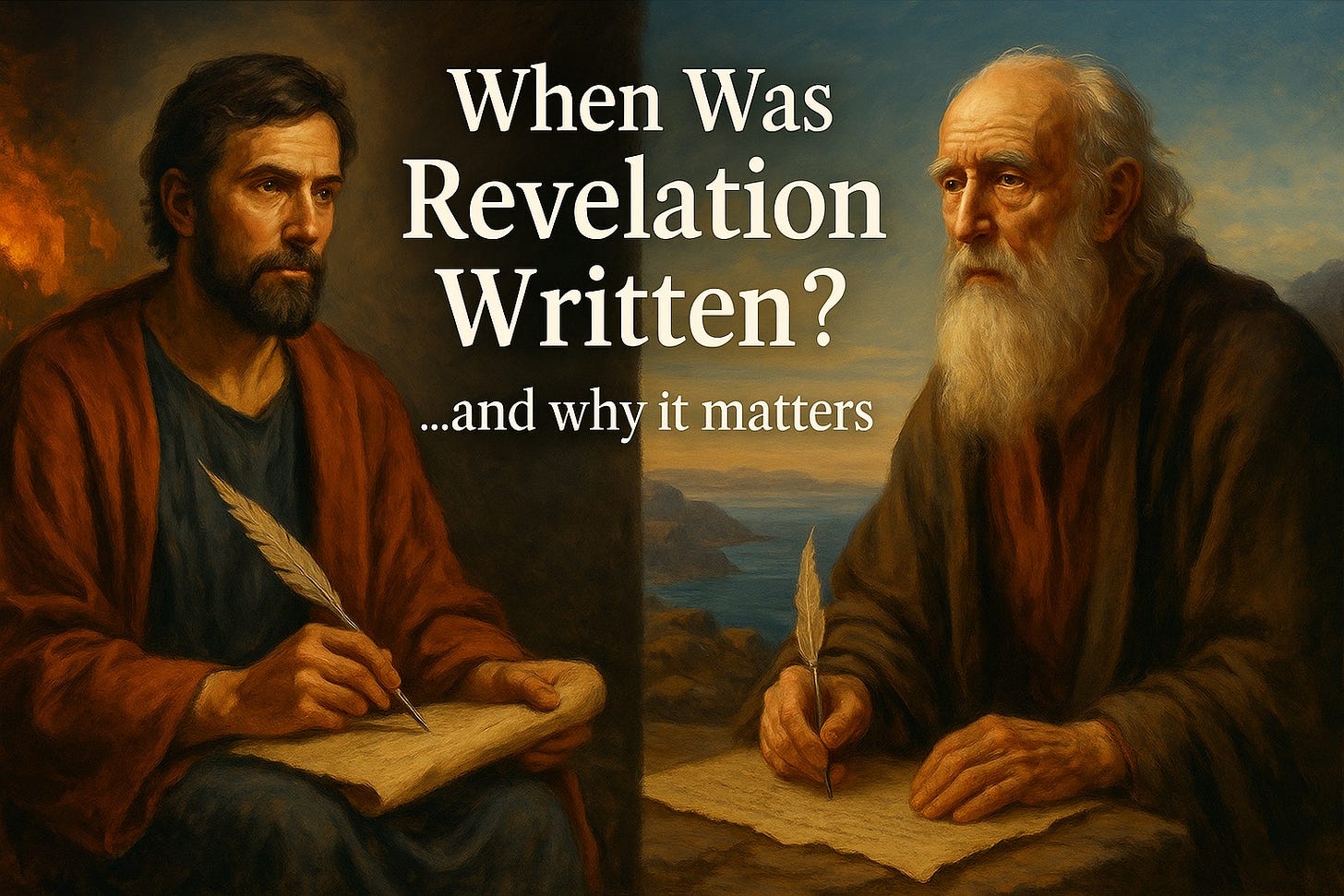When Was the Book of Revelation Written? —And Why it Matters.
One of the most overlooked but consequential debates in all of biblical interpretation is the dating of the Book of Revelation. Whether it was written before or after the destruction of the Jerusalem temple in A.D. 70 isn’t just a question of ancient history—it affects how Christians read prophecy, understand the mission of the Church, and even how they respond to current events in the Middle East.
There are two dominant views: the early date, placing Revelation in the mid-to-late 60s under Emperor Nero, and the late date, placing it around A.D. 95–96 under Emperor Domitian. For the last several centuries, the late date has been considered the “traditional view,” but that designation might deserve closer scrutiny. The case for the early date— mostly built on internal scriptural evidence and corroborated by multiple early traditions—is far stronger than many realize.
The Traditional View: A Late Date Under Domitian
The strongest case for the late date rests on a statement from Irenaeus (c. A.D. 180), who wrote that the Apocalypse was “seen… at the end of Domitian’s reign.” This testimony, though debated, was repeated by later Church Fathers like Eusebius and Jerome, giving it historical weight. This brief line has been the cornerstone of the Domitian view ever since.
Due to the later church fathers repeating Irenaeus’ statement, it has the appearance of a broad consensus among church Fathers. But a closer look reveals that these testimonies are not independent confirmations—they are simply repetitions of Irenaeus, not fresh evidence. In other words, the supposed “chorus of witnesses” is more like an echo chamber, all tracing back to a single source—a source that even many critical scholars admit is ambiguous. The Greek phrasing used by Irenaeus may not refer to when the vision was received at all, but rather to when John himself was last seen alive (see endnote 1). Either way, it’s not a precise historical claim. It certainly doesn’t outweigh the detailed internal indicators provided by the text itself.
Another key argument for the late date is that Revelation reflects heavy Christian persecution under Domitian (A.D. 81–96), but the historical evidence for such a crackdown is weak. No contemporary Roman historians mention it, and later Christian sources like Melito and Tertullian offer only vague references. Even Eusebius provides little detail. Most modern scholars, including W.H.C. Frend and Donald Guthrie, acknowledge the evidence is thin. By contrast, Nero’s persecution (A.D. 64–68) is well-documented, with Christians scapegoated and executed publicly. If Revelation was written in a time of real tribulation, Nero’s reign—not Domitian’s—offers a far stronger historical fit.
The Internal Evidence: A Strong Case for an Early Date
While external tradition leans heavily on Irenaeus, the internal evidence from Revelation appears to point clearly toward an authorship date before A.D. 70.
The Temple Is Still Standing (Revelation 11:1–
John is told to “measure the temple of God and the altar.” The natural reading of this passage assumes a functioning, physical temple. There is no language indicating that the temple had already been destroyed—something that would have been theologically and emotionally massive for any first-century Jewish-Christian author. The silence on this event is telling.
The Number of the Beast Points to Nero (Revelation 13:18)
The author calls on the reader to “calculate the number of the beast,” and explicitly states that it is “the number of a man…666.” Using Hebrew gematria, the name “Nero Caesar” (transliterated into Hebrew as Neron Qesar) adds up to exactly 666. The variant 616, found in some early manuscripts, corresponds to the Latin spelling of the same name.
This decoding only works if the readers understood Hebrew, which fits a Jewish-Christian audience before the temple’s fall. The author clearly expected his readers to figure it out—suggesting the man in question was alive or freshly remembered at the time of writing.
Revelation 17:10 – The Sequence of Emperors
John describes a line of kings: “Five have fallen, one is, the other has not yet come; and when he does come, he must remain only a little while.” If we count from Julius Caesar or Augustus, the sixth emperor is Nero—“the one who is.” His successor, Galba, reigned for only seven months, fulfilling the prophecy that the next king would remain “only a little while.”
This is a strikingly accurate snapshot of the Roman imperial timeline as it existed in the 60s, not the 90s. By Domitian’s time, that short-reigned king would have been long gone, making this passage a poor fit for a late date.
Become a paid subscriber for the rest of this article as well as access to all of my paid only exclusive content.




